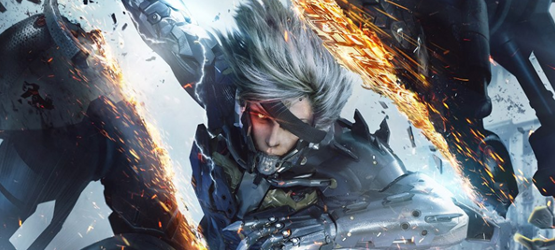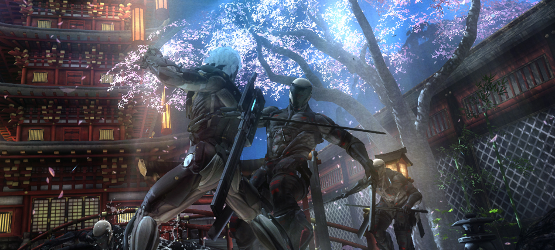
In Metal Gear Solid 2: Sons of Liberty, series creator and legend Hideo Kojima pulled a fast one on fans expecting another espionage mission starring Solid Snake. Instead, we got the frail-looking, blonde, and at one point naked and cartwheeling, Raiden. And, although Raiden’s legacy didn’t start off very strong (the game still remains my favorite of the series), his return in Metal Gear Solid 4: Guns of the Patriots as a Grey Fox-esque ninja cyborg wielding a deadly blade not only earned his redemption, but it left fans wanting to see what happened that led to Raiden becoming a cyborg. Metal Gear Rising: Revengeance isn’t that story, but it does provide the opportunity to see this other side of Raiden—a side where he slices and dices foes instead of grabbing his bare crotch while femininely flipping across a hallway.
Raiden, in his new badass form, should have made for an epic tale and one exhilarating action ride – you know, “Lightning Bolt Action” – except the development process hit more than a few snags, leading to Hideo Kojima cancelling the project. Eventually, something happened, development resumed, but was instead placed in the hands of the very capable Platinum Games. The end result is a game that struggles to find itself, much like the Raiden character we’ve been playing as since MGS2.

You can almost tell where things started going awry as, about midway through, the game it feels as though the developers had given up. Chapters that once took anywhere between 45 minutes to an hour to complete, become no more than 20 minutes. It’s as if they just wanted to put the game, and themselves, out of misery. It’s not clear at what point KojiPro wanted to pull the plug, but they were right in wanting to do so. However, it’s not all bad. The opening scenes and first twenty minutes or so of gameplay shows quite a spark. A ridiculously over the top spark, but it was the “Lightning Bolt Action” I was expecting from Platinum Games nonetheless. Raiden is definitely a force. He’s working for Maverick Security, a private military company that protects and serves their client. In this case, the client is the Prime Minister of Africa, whose motorcade is attacked by a group of cyborg ninjas just as powerful and capable as Raiden himself. It’s clear that war and the war economy has created the need to turn humans into weapons.
A Metal Gear Ray attacks Raiden, and he swiftly runs along an incoming barrage of missiles, leaping to the head of Ray, then slicing it down the middle. The entire sequence takes only a few minutes and makes Raiden seem unstoppable. But it’s yet another reason that it’s so frustrating to moments later lose to a barely armed regular enemy. He just decimated a feared weapon of mass destruction, but then gets his tail handed to him by the most generic of enemies—it doesn’t make sense. Eventually, Raiden is overcome, and the Prime Minister is murdered, bringing about Raiden’s need to take ‘revengeance’.
The word itself is as nonsensical as the rest of the story, which quickly becomes convoluted and warped into one that’s not even worth following along with. Raiden wants to protect the weak, and struggles with ruthless killing, yet he kills everything in his path. All to save the harvested brains of children doomed to become cyborg killing machines like himself. A plot to assassinate the President of the United States formulated by some roided up Senator is mixed in for good measure.

Raiden, deft and skilled with his hi-frequency katana blade, can cut through any object, yet he cannot proceed to the next area due to invisible force-field walls blocking his way until he’s beaten all foes in the area. This must be in place to force players into combat, or else you might find yourself running through the entire game avoiding all enemy encounters.
Why, if Raiden is so deadly, would you run away from everything? Because every fight—from the weakest of enemies, to the anger-inducing boss fights—is frustrating. Frustrating due to the camera. More frustrating due to the over-reliance of the parry system, which just so happens to be the same button as the attack button. That’s right—no dedicated block or parry, and no way to dash out of the way of enemy attacks. Then enemies constantly circle you to strike, and are almost always out of view by the horrid camera positioning, leaving you defenseless and mad. If you do have clear visibility of an incoming enemy strike, which will shine red to let you know it’s coming, you have to press the attack button in hopes that you actually parry and don’t attack instead. Maybe 25% of the time the parry actually works. Unless you’re playing on Easy, then the game auto-parries for you making the game too easy.
I played through the game on Normal, and on a number of occasions I considered either smashing my controller to bits, or quitting the game entirely and writing my review up until that point. I persevered, but I still ended up giving up at the final form of the last boss (at least I hope it was the final form, since I already beat many other forms). I did not complete the game. I did not finish the last boss. On normal. This is something that would bring great shame to me had this been an actual challenge, and not difficult only because combat is such a joke. Truthfully, it wasn’t worth the stress fighting him again and again and again— a stress I had already endured on previous boss fights. I stuck those out, and felt no satisfaction in doing so.

Worse yet, for a series known for having some of the most memorable villains and boss fights in video game history, Metal Gear Rising: Revengeance has some of the most pathetic, bland villains I’ve seen. I didn’t fear them for being ferocious, I feared them because I knew how poorly designed each fight was and how infuriating the next one would be. Even the supporting cast suffered from being completely generic and useless. Talking to them over codec… I just wanted it to stop. But they had so much to say, and so did the enemies. Hours of talking. Hours of cutscenes. All leading up to only five hours of play time, not taking the many times I died and retried into account—which was a lot; more than I could stand.
For every glimmer of excitement, there was an immediate let down. The one really great thing I can say about the game, is that I absolutely loved Zandatsu. Slowing down time to chop an enemy into pieces is wonderful 98% of the time. That other 2%, well, if you actually do play MGR, you’ll see for yourself during a boss fight with Sundowner. During this slow-time Zandatsu, if you’ve weakened an enemy enough, a target will appear that you must aim and time a slice across to reveal their energy spines. Doing so replenishes Raiden’s health and Zandatsu meter. I can see the potential here, but it’s difficult to perform on larger enemies, so instead it just guarantees that every larger battle is accompanied by weak grunts spread everywhere so you have means to refuel yourself. None of it is enough to make up for the rest of the gameplay, though.
I thought that maybe if I played some VR Missions—which you unlock by discovering data cases strewn about the linear path to completion and only serve as a weak attempt at adding exploration—that I could hone my skills, get used to the awful parry system, and have a less frustrating time. Sadly, the VR Missions are just as poorly done, offering little challenge, or training. They only make the environments even more boring and lifeless than the ones found in the game by taking away textures and obstacles.

Another shred of hope: at the end of each chapter you are given the chance to upgrade Raiden’s cyborg body and weaponry. Unfortunately, outside of seeing the number increase when bolstering Raiden’s help, anything I unlocked and purchased was barely noticeable in combat. It also allowed you to purchase the weapons that each boss used against you. I bought them, but I saw little point in using them. Nor is there a point in using any of the sub-weapons like RPGs or grenades found throughout the game. They take too long to lock onto a target or prepare given how fast-moving all of the enemies are—they’ll just get you killed.
Despite bearing the name, this is no Metal Gear game. At least not like you’re used to. This would have been good and fine for Raiden to have a game of his own outside the Metal Gear Solid universe, that’s filled with action instead of stealth. But, then why have stealth? Why have a soliton radar? You rarely use either, and it doesn’t quite fit in the fast-paced action confusion. Hideo Kojima was right in cancelling Metal Gear Solid: Rising—it just didn’t work. Even he saw that. Instead, someone at Konami had the bright idea to let Platinum Games take over the development. From the ashes, Metal Gear Rising: Revengeance was born, and like any problem child that grows up into an insufferable disappointment, it’ll leave a stain on the reputation of the parents: revered developers Platinum Games and Kojima Productions.
-
Zandatsu is cool and satisfying.
-
There are a few badass action sequences.
-
The misery, I mean game, ends in five hours.
-
Where do I begin?
-
Awful parry system.
-
Constantly obstructed camera and narrow rooms blocking view.
-
Enemies are overly difficult, and circle out of vision.
-
Bosses cannot be hit at times, adding to the ample frustration.
-
Bosses, grunts, even supporting characters are bland and forgettable.
-
Stealth and exploration are only partially done, and useless.
-
Story? What story? Oh, that mess.
-
VR Missions aren't worth playing. Offer no training opportunity.
-
Upgrades have little effect.
-
Did I mention how bad the parry and camera system are?
-
This game should have remained cancelled.








